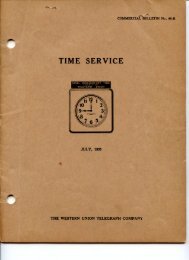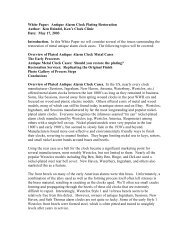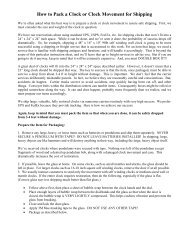Self Winding Clock Voltage Guide (Non-slave ... - Ken's Clock Clinic
Self Winding Clock Voltage Guide (Non-slave ... - Ken's Clock Clinic
Self Winding Clock Voltage Guide (Non-slave ... - Ken's Clock Clinic
- No tags were found...
Create successful ePaper yourself
Turn your PDF publications into a flip-book with our unique Google optimized e-Paper software.
<strong>Self</strong> <strong>Winding</strong> <strong>Clock</strong> <strong>Voltage</strong> <strong>Guide</strong>(<strong>Non</strong>-<strong>slave</strong> clocks)Note: This guide is a work in process. Last updated 1-15-2010Manufacturer <strong>Clock</strong> Type <strong>Voltage</strong> Recommended Power Source Comments<strong>Self</strong> <strong>Winding</strong> <strong>Clock</strong> Co. Style A, C, F with ..008” x.220” x 72” spring; 5.6 Ωcoil3 volts Model 1900GS or RS Kit if clock hassynchronizer coils. Model 1900L ifclock has no synchronizer kit.<strong>Self</strong> <strong>Winding</strong> <strong>Clock</strong> Co. Style A, C, F with .010”spring, 5.6 Ω coil<strong>Self</strong> <strong>Winding</strong> <strong>Clock</strong> Co. Style A, C, F with .010” x.220” x 72” spring; 200Ωcoil(called Telco clocks)<strong>Self</strong> <strong>Winding</strong> <strong>Clock</strong> Co. Style E 6 volts Pair of Model 1900G-3VN or pair ofModel 1900R2-3V. Connect twounits in series.<strong>Self</strong> <strong>Winding</strong> <strong>Clock</strong> Co.American <strong>Clock</strong> Co.American StandardWatch Co.Standard Electric <strong>Clock</strong>Co.Standard Electric <strong>Clock</strong>Co.Some Style F Later Models,S/N 300000 or above with Rprefix using enclosed DCmotor“Getty” movement with pairof weighted armsHipp Toggle <strong>Self</strong> <strong>Winding</strong>80 beat (contact us for 60beat)Units with two From 4.5 volts toelectromagnetic coils at 24 volts. The 24base of movement, impulse volt unit is mostwound once per minute, common.helical mainspringMotor wound weight driven 24 volts AC, 120volts or 240 voltsACMost common clock; dials 16 inches andsmaller. Requires 180-210mA for an 8-15sec/hour wind for F style and 400mA for 5-6sec/hr with A or C style rotary motor.3 volts Same as above. <strong>Clock</strong>s with attachments to seconds shaft suchas <strong>slave</strong> switches, or clocks with large dials.24 volts Model 1900-24V Kit or single1900R2-24V3 volts Model 1900G-3VN or Model1900R2-3V. Do not try to use anyother battery, as these are the onlyunits that will have the capacity tostart the motor and provide goodbattery life.3 volts One Model 1900G-3VN or Model1900R2-3V3 volts One Model 1900G-3VN or Model1900R2-3V.Model 1900W-UNV available eitheras a small 2” tall “hockey puck”module or No. 6 battery kit.No battery solution for these clocksMonarch Master <strong>Clock</strong> Minute Impulse 4.5 volts Model 1900GS-4.5V or Model1900R2-4.5VOften, but not always, there is a tag on the clockthat specifies 24 volts. Style F movementsidentical to 3 volt unit. Requires 46-50mA for12-15 second wind per hour.Uncommon<strong>Self</strong> <strong>Winding</strong> <strong>Clock</strong> Co. used an enclosed 3 voltmotor in some clocks circa 1950 for broadcaststudio version. Requires up to 3 amps to start, 1amp to run, for about 1-2 sec/hour depending oncondition of motorRequires 0.5-1A for about 200ms every 5-7minutes depending on size of clock.Requires 0.5-1A for about 200ms every 2-4minutes depending on size and condition ofmovement.Model 1900W-UNV <strong>Clock</strong> Winder can beconnected directly to coil, conserving contactsand greatly improving battery efficiency. TheModel 1900W-UNV will determine therequired, proper voltage and apply it.Requires AC powerThese clocks utilize a single 12 ohm coilrequiring 4.5 volts to properly activate winding.They can be adjusted to wind on 3 volts butefficiency (battery life) is poor and themovement will run without much power. With4.5 volts, properly adjusted movement willwind in under 100ms and run well.
<strong>Self</strong> <strong>Winding</strong> <strong>Clock</strong> <strong>Voltage</strong> <strong>Guide</strong>(<strong>Non</strong>-<strong>slave</strong> clocks) Page 2Note: This guide is a work in process. Last updated 1-15-2010Comments Comments Comments Comments CommentsStrombergMinute Impulse styleVintage Master <strong>Clock</strong>s w/.008” x .250” x 40” springModel 1900W-UNV10 volts mostcommon, butothers produced(up to 24 volts)Like the Standard Electrics, the impulse drivenStrombergs can be driven directly to the coil bythe Model 1900W-UNV. The Model 1900W-UNV will determine the required, propervoltage and apply it.Stromberg Same as Above 110 volts Model 1900W-110V High voltage unit provides proper signal towind clock. Connect directly to coil, bypassingcontacts and therefore avoiding effects fromburned out contacts (particularly notable withthe 110 volt units). Coils are usually marked ifunit is 110 volts.Synchronome All A frame movements 3-4.5 volts 1900R2 on float charge. Contact us. Movements virtually the same from 1908 to1962. Requires 295-320mA for a 5 second perminute impulse. Add 1 volt per <strong>slave</strong>movement connected in series.English <strong>Clock</strong> Systems(ECS)Smiths Gravity Arm 10-10.5 volts Contact us Requires 300-320mA





